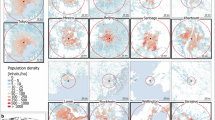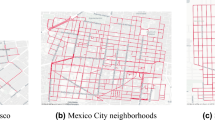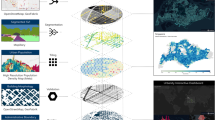Abstract
Cities can be organized into properties, streets, ‘neighborhoods’ and more, posing a challenge for urban science. The pointillistic perspective on cities integrates multiple geographic scales in theory, research and policy by emphasizing the distinct processes that operate at each scale and their interactions. My goal is partially to rectify an overreliance on neighborhoods, revealing underappreciated microspatial inequities. I apply it to two topics with neighborhood-centric histories and burgeoning place-based literatures—crime and environmental justice—and explore how it can generalize to other scales (for example, cities), guide work with novel data fueling urban informatics, and inform equitable policymaking.
This is a preview of subscription content, access via your institution
Access options
Subscribe to this journal
Receive 12 digital issues and online access to articles
$119.00 per year
only $9.92 per issue
Buy this article
- Purchase on SpringerLink
- Instant access to full article PDF
Prices may be subject to local taxes which are calculated during checkout


Similar content being viewed by others
References
Bettencourt, L. M. A. The origins of scaling in cities. Science 340, 1438–1441 (2013).
Batty, M. The New Science of Cities (MIT Press, 2013).
O’Brien, D. T. Urban Informatics (CRC Press/Chapman & Hall, 2023).
Glaeser, E. L. The Triumph of Cities: How Our Greatest Invention Makes Us Richer, Smarter, Greener, Healthier and Happier (Penguin, 2011).
Openshaw, S. The Modifiable Areal Unit Problem, CATMOG (GeoBooks, 1984).
Sampson, R. J., Morenoff, J. D. & Gannon-Rowley, T. Assessing ‘neighborhood effects’: social processes and new directions in research. Annu. Rev. Sociol. 28, 443–478 (2002).
Galster, G. On the nature of neighbourhood. Urban Stud. 38, 2111–2124 (2001).
Weisburd, D. The law of crime concentration and the criminology of place. Criminology 53, 133–157 (2015).
Whyte, W. H. The Social Life of Small Urban Spaces (Project for Public Spaces, 1980).
Johnston, R. et al. Scale, factor analyses and neighborhood effects. Geogr. Anal. 36, 350–368 (2004).
Jones, R. W. & Pridemore, W. A. Toward an integrated multilevel theory of crime at place: routine activities, social disorganization and the law of crime concentration. J. Quant. Criminol. 35, 543–572 (2019).
O’Brien, D. T. The Pointillistic City (MIT Press, 2024).
King, G. A Solution to the Ecological Inference Problem (Princeton Univ. Press, 1997).
Diez-Roux, A. V. Bringing context back into epidemiology: variables and fallacies in multilevel analysis. Am. J. Public Health 88, 216–222 (1998).
Petrovic, A., Manley, D. & van Ham, M. Freedom from the tyranny of neighbourhood: rethinking sociospatial context effects. Prog. Hum. Geogr. 44, 1103–1123 (2020).
Zhang, M. & Kukadia, N. Metrics of urban form and the modifiable areal unit problem. Transp. Res. Rec. 1902, 71–79 (2005).
Fowler, C. Segregation as a multiscalar phenomenon and its implications for neighborhood-scale research: the case of South Seattle 1990-2010. Urban Geogr. 37, 1–25 (2016).
Park, R. E., Burgess, E. W. & McKenzie R. D. The City: Suggestions for Investigation of Human Behavior in the Urban Environment (Univ. of Chicago Press, 1984 [1925]).
Shaw, C. & McKay, H. Juvenile Delinquency and Urban Areas (Univ. of Chicago Press, 1969 [1942]).
Kawachi, I. & Berkman, L. F. (eds) Neighborhoods and Health (Oxford Univ. Press, 2003).
Leventhal, T. & Brooks-Gunn, J. The neighborhoods they live in: the effect of neighborhood residence on child and adolescent outcomes. Psychol. Bull. 126, 309–337 (2000).
Chetty, R., Hendren, N. & Katz, L. F. The effects of exposure to better neighborhoods on children: new evidence from the Moving to Opportunity experiment. Am. Econ. Rev. 106, 855–902 (2016).
Sampson, R. J. Great American City: Chicago and the Enduring Neighborhood Effect (Univ. of Chicago Press, 2012).
Moro, E., Calacci, D., Dong, Z. & Pentland, A. Mobility patterns are associated with experienced income segregation in large US cities. Nat. Commun. 12, 4633 (2021).
O’Brien, D. T., Ristea, A. & Dass, S. Exposure to infection when accessing groceries reveals racial and socioeconomic inequities in navigating the pandemic. Sci. Rep. 13, 2484 (2023).
Hipp, J. R. & Boessen, A. Egohoods as waves washing across the city: a new measure of ‘neighborhoods’. Criminology 51, 287–327 (2013).
Coulton, C. J., Korbin, J., Chan, T. & Su, M. Mapping residents’ perceptions of neighborhood boundaries: a methodological note. Am. J. Commun. Psychol. 29, 371–383 (2001).
Sharkey, P. & Faber, J. W. Where, when, why, and for whom do residential contexts matter? Moving away from the dichotomous understanding of neighborhood effects. Annu. Rev. Sociol. 40, 559–579 (2014).
Brantingham, P. J. & Brantingham, P. L. Patterns in Crime (Macmillan, 1984).
Madensen, T. D. & Eck, J. E. in Oxford Handbook of Criminological Theory (eds Cullen, F. T. & Wilcox, P.) 554–578 (Oxford Univ. Press, 2013).
Du Bois, W. E. B. The Philadelphia Negro: A Social Study (Univ. Philadelphia, 1899).
Turner, B. L. et al. A framework for vulnerability analysis in sustainbility science. Proc. Natl Acad. Sci. USA 100, 8074–8079 (2003).
Jencks, C. & Mayer, S. in Inner-City Poverty in the United States (ed. Lynn Jr, L. E.) 111–185 (National Academy Press, 1990).
Wilson, W. J. The Truly Disadvantaged: The Inner City, the Underclass and Public Policy (Univ. Chicago Press, 1987).
Sherman, L. W., Gartin, P. R. & Buerger, M. E. Hot spots of predatory crime: routine activities and the ciminology of place. Criminology 27, 27–55 (1989).
Cohen, L. E. & Felson, M. Social change and crime rate trends: a routine activity approach. Am. Sociol. Rev. 44, 588–608 (1979).
Steenbeek, W. & Weisburd, D. Where the action is in crime? An examination of variability of crime across different spatial units in The Hague, 2001–2009. J. Quant. Criminol. 32, 449–469 (2016).
Boessen, A. & Hipp, J. R. Close-ups and the scale of ecology: land uses and the geography of social context and crime. Criminology 53, 399–426 (2015).
O’Brien, D. T. The action is everywhere, but greater at more localized spatial scales: comparing concentrations of crime across addresses, streets and neighborhoods. J. Res. Crime Delinq. 56, 339–377 (2019).
O’Brien, D. T. & Ciomek, A. Whence the action? The persistence and aggravation of violent crime at addresses, streets and neighborhoods. J. Res. Crime Delinq. https://doi.org/10.1177/00224278221112839 (2022).
Taylor, R. B., Haberman, C. P. & Groff, E. R. Urban park crime: neighborhood context and park features. J. Criminal Justice 64, 101622 (2019).
Tillyer, M. S., Wilcox, P. & Walter, R. J. Crime generators in context: examining ‘place in neighborhood’ propositions. J. Quant. Criminol. 37, 517–546 (2021).
Bullard, R. D. Dumping in Dixie: Race, Class and Environmental Quality (Westview Press, 1994).
Bullard, R. D. & Wright, B. (eds) Race, Place and Environmental Justice after Hurricane Katrina (Westview Press, 2009).
Cutter, S. L. Race, class and environmental justice. Prog. Hum. Geogr. 19, 111–122 (1995).
Agyeman, J., Schlosberg, D., Craven, L. & Matthews, C. Trends and directions in environmental justice: from inequity to everyday life, community and just sustainabilities. Annu. Rev. Environ. Resour. 41, 321–340 (2016).
Huang, G. & Cadenasso, M. L. People, landscape and urban heat island: dynamics among neighborhood social conditions, land cover and surface temperatures. Landscape Ecol. 31, 2507–2515 (2016).
Xie, X., Liu, C. & Leung, D. Y. Impact of building facades and ground heating on wind flow and pollutant transport in street canyons. Atmos. Environ. 41, 9030–9049 (2007).
Fini, A., Frangi, P., Mori, J., Donzelli, D. & Ferrini, F. Nature based solutions to mitigate soil sealing in urban areas: results from a 4-year study comparing permeable, porous and impermeable pavements. Environ. Res. 156, 443–454 (2017).
O’Brien, D. T., Gridley, B., Trlica, A., Wang, J. & Shrivastava, A. Urban heat islets: street segments, land surface temperatures and medical emergencies during heat advisories. Am. J. Public Health 110, 994–1001 (2020).
Rai, M. et al. Heat-related cardiorespiratory mortality: effect modification by air pollution across 482 cities from 24 countries. Environ. Int. 174, 107825 (2023).
O’Brien, D. T. & Mueller, A. V. In pursuit of local solutions for climate resilience: sensing microspatial inequities in heat and air pollution within urban neighborhoods in Boston, MA. Sustainability 15, 2984 (2023).
Sabrini, S., Karimi, M. & Nazari, R. Developing vulnerability index to quantify urban heat islands effects coupled with air pollution: a case study of Camden, NJ. Int. J. Geo-Inf. 9, 349 (2020).
O’Brien, D. T. & Montgomery, B. W. The other side of the broken window: a methodology that translates building permits into an ecometric of investment by community members. Am. J. Community Psychol. 55, 25–36 (2015).
Papachristos, A. V., Smith, C. M., Scherer, M. L. & Fugiero, M. A. More coffee, less crime? The relationship between gentrification and neighborhood crime rates in Chicago, 1991 to 2005. City Community 10, 215–240 (2011).
Leventhal, T. Neighborhood context and children’s development: when do neighborhoods matter most? Child Dev. Perspect. 12, 258–263 (2018).
Harding, D. J. Living the Drama (Univ. of Chicago, 2010).
Sharkey, P. The acute effect of local homicides on children’s cognitive performance. Proc. Natl Acad. Sci. USA 107, 11733–11738 (2010).
O’Brien, D. T., Hill, N. E. & Contreras, M. Community violence and academic achievement: high-crime neighborhoods, hotspot streets and the geographic scale of ‘community’. PLoS ONE 16, e0258577 (2021).
Wang, Q., Phillips, N. E., Small, M. L. & Sampson, R. J. Urban mobility and neighborhood isolation in America’s 50 largest cities. Proc. Natl Acad. Sci. USA 115, 7735–7740 (2018).
Raudenbush, S. W. & Bryk, A. Hierarchical Linear Models: Applications and Data Analysis (Sage, 2002).
Gelman, A., Shor, B., Bafumi, J. & Park, D. Rich state, poor state, red state, blue state: what the matter with Connecticut? Q. J. Polit. Sci. 2, 345–367 (2007).
Fotheringham, A. S., Brundson, C. & Charlton, M. Geographically Weighted Regression: the Analysis of Spatially Varying Relationships (Wiley, 2002).
Foth, M. (ed.) Handbook of Research on Urban Informatics: the Practice and Promise of the Real-Time City (IGI Global, 2009).
Lazer, D. M. J. et al. Computational social science: obstacles and opportunities. Science 369, 1060–1062 (2020).
Richardson, R., Schultz, J. M. & Crawford, K. Dirty data, bad predictions: how civil rights violations impact police data, predictive policing systems, and justice. NYU Law Rev. Online 15, 192–233 (2019).
Boston Smart City Playbook (Boston Mayor’s Office of New Urban Mechanics (MONUM), 2017).
Lewin, K. Psychology and the process of group living. J. Soc. Psychol. 17, 113–131 (1943).
Zoorob, M. & O’Brien, D. T. Pacifying problem places: how problem property interventions increase guardianship and reduce disorder and crime. Criminology 62, 64–89 (2024).
Acknowledgements
I thank E. Moro, R. Tucker and R. Qi Wang for feedback on earlier drafts of this essay.
Author information
Authors and Affiliations
Contributions
D.T.O. conceptualized and wrote the paper.
Corresponding author
Ethics declarations
Competing interests
The author declares no competing interests.
Peer review
Peer review information
Nature Cities thanks Martin A. Andresen, David Manley and Jonathan K. Nelson for their contribution to the peer review of this work.
Additional information
Publisher’s note Springer Nature remains neutral with regard to jurisdictional claims in published maps and institutional affiliations.
Rights and permissions
Springer Nature or its licensor (e.g. a society or other partner) holds exclusive rights to this article under a publishing agreement with the author(s) or other rightsholder(s); author self-archiving of the accepted manuscript version of this article is solely governed by the terms of such publishing agreement and applicable law.
About this article
Cite this article
O’Brien, D.T. The pointillistic city and geographic scale in urban science. Nat Cities 2, 379–386 (2025). https://doi.org/10.1038/s44284-025-00237-7
Received:
Accepted:
Published:
Issue date:
DOI: https://doi.org/10.1038/s44284-025-00237-7



